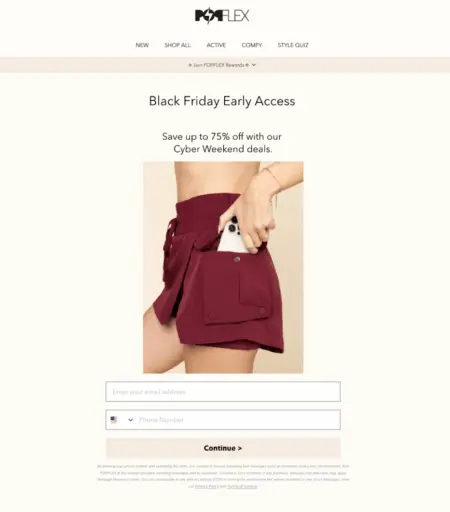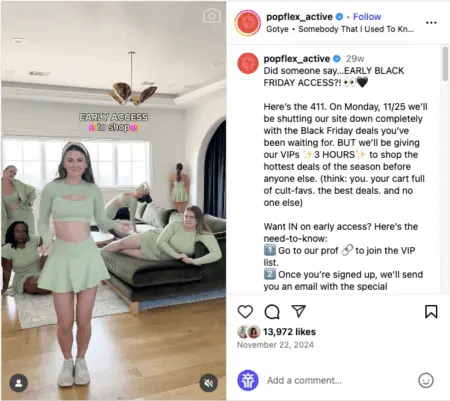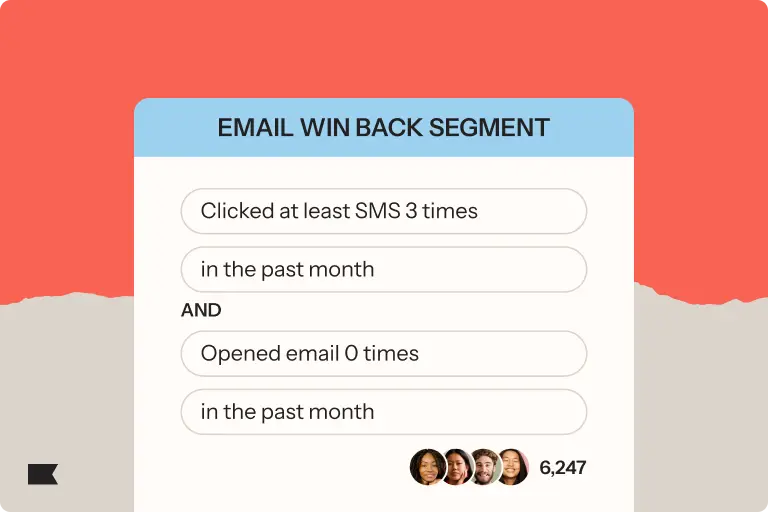How to use web forms to grow your lists before BFCM

Black Friday Cyber Monday (BFCM) can drive several months’ worth of revenue—if you start planning now. That means focusing on growing your email, SMS, and WhatsApp lists between July and October.
The subscribers you collect now—and the zero-party data they volunteer—are essential for smarter targeting, segmentation, personalization, and testing. One of the most effective ways to capture that data is the classic web form.
Paired with the right tactics, web forms like pop up forms are one of the best ways to collect data ahead of BFCM. Let’s take a look at how to use and create web forms that turn visitors into BFCM buyers and long-term loyal customers.
5 types of web forms for collecting valuable customer data
Web forms capture the zero-party data you need to grow your lists and personalize offers ahead of BFCM—emails, phone numbers, birthdays, preferences, and more.
But what is a web form in the first place? There are several types:
- Pop up forms appear in the middle of browser windows, prompting interaction while the rest of the site is visible. They’re great for new visitors or exit-intent offers.
- Fly-out forms slide in while people browse, often staying on the edge of the screen—ideal for subtle promos or reminders.
- Embedded forms can live anywhere on a page (usually in the footer) and support always-on list growth.
- Full-page forms fill the entire browser window and are designed to capture shoppers’ attention for special events like BFCM. They’re perfect for highlighting special offers in exchange for email or SMS sign-ups. Keep in mind that people will need to close the form or fill it out to keep browsing.
- Banner forms stick to the top or bottom of screens and are useful for specific incentives like free shipping and limited-time offers.
Choosing the right form can drive early results. Apparel brand POPFLEX has had this full-page form for early BFCM access live since February, inviting shoppers to subscribe by email and phone for up to 75% off during Cyber Weekend.

Image source: POPFLEX
Omnichannel list growth considerations
You don’t just need a big list to drive revenue during BFCM. You need the right sign-up forms in the right places to capture high-intent subscribers and stay compliant.
That’s because today’s customer journey isn’t linear—it’s omnichannel. Shoppers jump between channels, from discovering your brand on social media to browsing on mobile and buying in-store. Omnichannel means offering options to opt in to various kinds of marketing messaging, so you can meet people wherever they are with a consistent, cohesive experience.
During BFCM, when competition is high and attention spans are short, successful brands make it easy for customers to opt in across channels by using clear, well-placed web forms. That means each form needs to be optimized for the channel it’s promoting and follow proper compliance.
Remember: consent on one platform doesn’t carry over to another.
How to create compliant email sign-up forms to capture email addresses
The best BFCM email list growth strategies focus on helping you capture subscribers while staying compliant and increasing your chances of landing in inboxes. Consider these best practices:
- Focus on compliance and transparency. Make it clear that subscribers are opting in to receive marketing emails—not just transactional messages, and not just alerts related to BFCM.
- Make it clear subscribers can unsubscribe at any time. Make sure shoppers understand subscribing is optional, and that it’s easy to unsubscribe from email marketing whenever they want to.
- Use double opt-in. Ask new subscribers to confirm their subscription before they’re officially subscribed to your list. This helps reduce fake or low-quality sign-ups and improves deliverability.
How to create compliant SMS sign-up forms to capture phone numbers
Compliant SMS forms for BFCM should:
- Collect clear, explicit consent. Again, make it clear that subscribers are opting in to receive marketing texts, not just transactional messages. Always include disclosure language with links to your mobile terms of service and privacy policy.
- Use double opt-in. Here, too, make sure you ask new subscribers to confirm their subscription. Smart Opt-in automates this process for you: when a shopper inputs their phone number into a form, they receive a one-time code that they can click to autofill on iOS and Android browsers to confirm their consent for SMS marketing.
- Localize for different countries. Match sending numbers and form URLs to each region’s compliance requirements (e.g., TCPA in the US, GDPR in the EU, etc.).
- Include opt-out language. Make it clear how users can unsubscribe at any time (e.g., “Text STOP to opt out”).
How to create compliant WhatsApp sign-up forms to collect WhatsApp consent
Like email and SMS, WhatsApp is a permissions-based channel, which means you need to get clear, documented consent before you send a single message. In the lead-up to BFCM, you can use a WhatsApp sign-up form to build your WhatsApp list in a few key ways:
- Be clear about the types of messages you’ll be sending. As usual, you need separate permission for marketing vs. transactional messages.
- Use only pre-approved message templates to start conversations. Promotional content must also follow approved Meta message templates.
- Never send unsolicited messages. Doing this can get your number flagged or restricted.
- Always include your business name in messages. This provides clarity to subscribers and helps strengthen brand affinity.
If you’re using the WhatsApp Business Platform (API), you need to use pre-approved message templates for most outbound communications, especially anything that’s not a direct response to a customer enquiry. This is part of Meta’s policy to protect users from spam and ensure conversations are relevant and valuable, so that customers remain engaged.
Web form pro tip: Use multi-step forms to make it easier for visitors to share info and consent for multiple channels without overwhelming them with long forms all at once.
3 smart web form strategies for driving sign-ups before BFCM
For BFCM web forms to convert, they need 3 qualities:
- Good timing: Set your pop up forms to display at the optimal moment based on the shopper experience you’re going for.
- A compelling offer: Depending on the audience, your offer needs to be appealing and worthy of a visitor providing their info, without giving away too much.
- Mobile functionality: In 2024, more than 80% of Cyber Week traffic came from mobile phones. That means your forms need to respond to the type of device someone is using to view them.
Let’s take a closer look at each one of these elements:
1. Optimize web form timing and placement to maximize sign-ups
Use time delays and page view triggers so forms appear only after a visitor is engaged. Add exit-intent pop ups to catch shoppers before they bounce, and schedule forms to automatically launch or retire based on specific dates or times.
Test variations 4–6 weeks ahead of BFCM to find the highest-converting forms, and launch the winners well before the rush. You can skip the manual work with AI-powered forms display optimization, which generates and tests form variations to optimize their timing and placement on your website.
Natural skincare brand Tata Harper used forms display optimization to test 20 web form variations for email and SMS sign-ups, resulting in a 65% increase in submissions. Luxury blanket company Saranoni also tested placement and timing variations to find top performers for specific pages—and one drove a 14% lift in form submissions.
2. Select an incentive strategy that converts without hurting margins
Discounts are, by far, the most common sign-up incentive across channels. But not every sign-up incentive needs to be a discount. In fact, research shows that going big with discounts isn’t always the right move.
The key here is to align your offer with your sign-up form goal.One smart alternative, especially in the lead-up to a big sales event like BFCM: giving your VIP shoppers early access.
This approach can transform standard sales into exclusive perks by reframing the message from “open to all” to “reserved just for you.” It also appeals to higher-intent shoppers who might be interested in a more unique value add, especially during a time of year when they’re inundated with promises of big savings.
Here, see how POPFLEX uses a combination of social media and web forms to turn their BFCM lead-up into a high-impact event by offering VIPs a 3-hour head start on deals. Shoppers signed up for the VIP list via web form and received a special password via email, giving them early access to deals before the crowds.

Image source: POPFLEX Instagram
3. Implement mobile-first form design
The best mobile-friendly web forms are quick to complete and easy to navigate. Use single-step forms for low-commitment actions and multi-step forms when you need more data without overwhelming shoppers.
Make sure forms:
- Adjust to any screen size.
- Use tap-friendly buttons and fields.
- Only ask for essential information.
- Load quickly with a lightweight design.
Advanced BFCM web form strategies for deeper personalization
If you’re only asking for emails or phone numbers, you’re missing a major opportunity. Ahead of BFCM (and even during it), you can also use your web forms to collect data that fuels future personalization—like which products someone wants, how they shop, where they live, and which channels they actually respond to.
These advanced strategies help you segment smarter and deliver more relevant, higher-converting offers when competition is at its peak.
Collect customer data for future targeting
Here are a few ways to gather data and identify specific interests and cohorts within your contact database:
- Collect product interests during sign-up to deliver relevant recommendations and promotions when deals go live. You can do this by adding questions to your standard sign-up forms, like “What’s on your BFCM wishlist?” But you can also replace standard sign-up forms with product quizzes and wishlist builders.
- Track and tag new subscriber sources to personalize future targeting so you know where people signed up—a standard sign-up form, an early-access form, a giveaway, a product quiz, a wishlist, etc. This information can signal what kinds of content the subscriber is more likely to find interesting later on. Someone who takes a product quiz, for example, probably has higher intent than someone who signed up for the chance to win a giveaway.
- Capture shoppers’ channel preferences (email, SMS, or both) so you can reach them where they’re most responsive during the rush.
Before BFCM 2023, POPFLEX ran an October giveaway requiring entrants to create wishlists. Nearly 100,000 shoppers entered, giving the team plenty of valuable customer data to use for personalized holiday messaging.
“The beauty of the wishlist giveaway is that it makes the customer engage with your product,” says Jen-Ai Notman, VP of marketing at POPFLEX. “We know the products that they’re interested in, and they have much higher intent going into the holiday season.”
Display targeted forms to specific audience segments
Forms that are tailored to customers based on their actual behavior are more relevant and therefore more likely to convert. During BFCM, use the customer data you have to show different forms to different people.
For example, you can:
- Show forms indicating free shipping thresholds to high-LTV shoppers.
- Create a pop up that promotes a relevant product bundle based on the preferences someone selected when they signed up.
- Leverage geographic data to localize offers, from international shipping cutoffs to local events.
- Segment new vs. returning shoppers to boost conversions by offering strong incentives to first-timers and exclusive early access to loyal customers.
- Use RFM analysis to segment customers based on how recently and frequently they’ve purchased and how much they’ve spent, then target unique forms accordingly. You might, for example, include a discount on an exit intent form for a customer who’s at risk of churning, but replace the incentive offer with product recommendations for a champion customer who just bought something earlier in the sale period.
Measuring and optimizing web form performance
Treat forms like any other performance channel. That means tracking key metrics, running A/B tests, and continuously refining to capture more subscribers.
Key metrics to track
These are the most useful form analytics during the lead-up to BFCM:
- Form submission rates help you understand how compelling your offers and incentives are.
- List growth velocity tracks how quickly your audience is growing.
- Subscriber-to-customer conversion shows how your follow-up flows perform.
- BFCM attribution from new subscribers helps connect form sign-ups to purchases.
A/B testing strategies
Try these A/B testing approaches to optimize form performance:
- Headline variations to identify the most compelling messages
- Form layout alternatives, including placement of fields and CTAs
- Incentive tests that compare free shipping, discounts, or prize giveaways
- Variations on timing and placement (remember, AI-powered forms display optimization can automate this for you)
Build list growth into your BFCM marketing strategy
Your best BFCM starts with strong lists. July–October is your window to build, test, and optimize your web forms so they’re ready to deliver.
With an easy-to-use native form builder, no-code solutions, custom HTML flexibility, and 70+ ready-made form templates, Klaviyo B2C CRM doesn’t just make it easy to launch high-converting forms—it gives you the ability to instantly centralize and take action on the customer data you collect.
Every sign-up, preference, and behavioral signal flows into a single source of truth, so you can personalize BFCM campaigns now and build smarter retention strategies long after the sales end.

Related content

Discover the best email marketing platform for ecommerce in 2026. Compare top tools for data, automation, personalization, and deliverability.

Learn how to use Klaviyo SMS, segmentation, and hybrid flows to re-engage lapsed email subscribers, boost deliverability, and drive higher retention.

Boost D2C email revenue from 12% to 30% with the Klaviyo playbook: high-converting pop-ups, a 5-email welcome series, smart filters, and optimized abandonment flows.